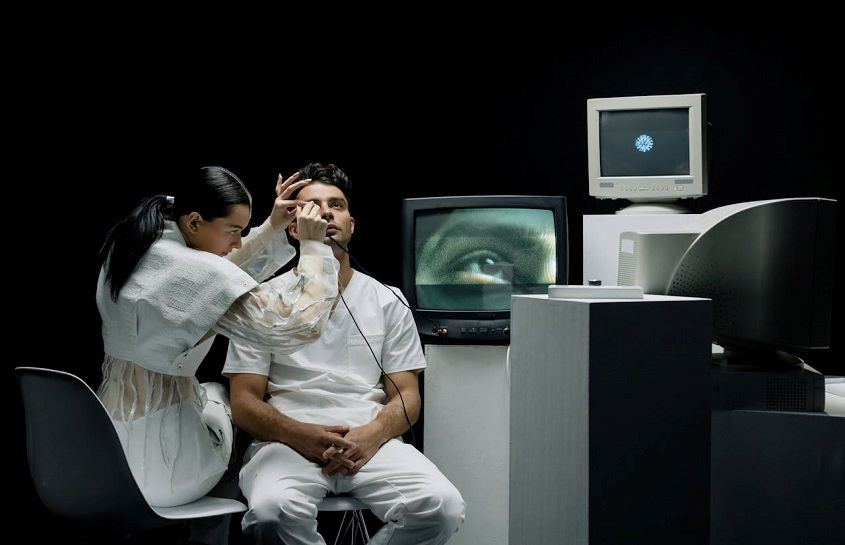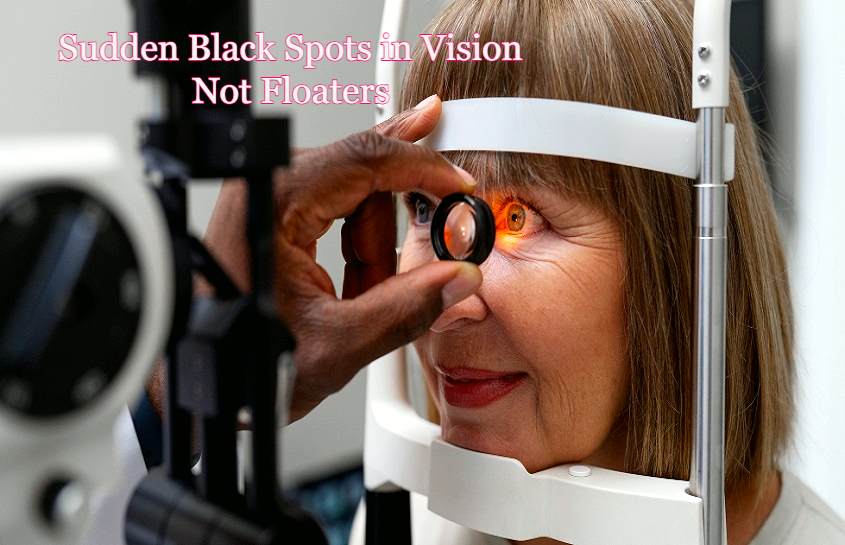Noticing sudden black spots in vision not floaters, can be unsettling, especially when they appear out of nowhere. Unlike traditional floaters, which drift slowly and change position with eye movement, these dark spots may remain fixed or obstruct a specific portion of your vision. Understanding the difference between harmless visual phenomena and symptoms of a serious eye condition is critical.
This comprehensive guide explores potential causes, associated symptoms, and recommended treatments for sudden black spots in vision, excluding typical floaters. If you’ve been searching for clarity or recently read experiences on platforms like Reddit or eye health forums, this article will provide reliable, reader-friendly information.
What are Floaters?
Floaters are small dark spots or threads that appear in your vision, which are often described as stains, cobwebs or threads. Given a light, regular surface, they are most noticeable, such as a clear sky or a white wall. Flotors occur when small lumps are made in Vitarus, a clear gel-like fabric inside the eye. These lumps cast a shadow on the retina and cause a feeling of liquid images. When the eyes walk on, they go, but float when the eyes are closed. Floaters are common with age and are usually harmless, although sudden growth can indicate a more serious problem as a retinal tear.
When It’s Not Floaters
A sudden black spot in vision not floaters, often appears suddenly and is firmer than floaters. This can block your central or peripheral view of view and occur with other symptoms such as light, headache or visual deformities. These differences indicate that something more serious in the eye.
1. What’s the Difference Between Black Spots and Floaters?
The main difference between black spots and floaters is that floaters move with your eye, while black spots often remain fixed and may signal a more serious underlying condition.
Comparison Table
| Feature | Black Spots (Not Floaters) | Floaters |
| Movement | Often fixed in place | Move with eye motion |
| Appearance | Dark, shadowy, or blocked area | Cobweb-like, stringy, or transparent dots |
| Cause | Possible serious condition (e.g., retinal damage) | Age-related changes in vitreous gel |
| Associated Symptoms | May include flashes, pain, or vision loss | Usually, no other symptoms |
| Urgency | May require immediate medical attention | Typically benign, but should be monitored |
| Response to Light Changes | Less responsive | More visible against bright backgrounds |
2. Common Causes of Sudden Black Spots
Understanding what causes these sudden changes is the first step toward effective treatment.
2.1 Retinal Tear or Detachment
One of the most essential causes of sudden black spots is a retinal tear or detachment. This happens when the retina is away from the underlying tissue. Symptoms include a sudden appearance of dark spots, flashes of light and an effect of a shade or curtain on your visual area. Without early treatment, it can cause permanent vision loss.
2.2 Posterior Vitreous Detachment (PVD)
PVD occurs when the vitreous gel separates from the retina, a process that is common with aging. Although it is often harmless, it can sometimes cause tears in the retina. Under PVD, the black spots that appear suddenly in sight will meet floators, but feel more infiltrated and sometimes with a light glow.
2.3 Diabetic Retinopathy
This condition affects individuals with diabetes and results from damage to the tiny blood vessels in the retina. If these vessels leak blood into the vitreous, dark spots may appear in the vision. Managing blood sugar levels and routine eye exams are essential to catch this condition early.
2.4 Hypertensive Retinopathy
Chronic high blood pressure can damage the retinal vessels and cause bleeding and black spots. These visual symptoms often match headaches or press behind the eyes. Sudden vision change with the history of high blood pressure should never be ignored.
2.5 Age‑Related Macular Degeneration (AMD)
By wet AMD grows abnormal blood vessels under the retina and leakage fluid or blood, causing sudden dark patches for central views. Dry AMD can also cause gradual blind spots, but sudden progress is possible. This condition mainly affects more than 50 individuals.
2.6 Uveitis (Inflammation in the Eye)
Uveitis refers to inflammation of the uvea, the eye’s middle layer. This inflammation can cause dark spots, blurred vision, redness, and pain. Autoimmune diseases or infections may trigger this condition, and it often requires corticosteroid treatment.
2.7 Migraine Aura
Migraines, particularly those with aura, can lead to temporary visual disturbances, including dark spots, zigzag lines, or shimmering lights. The sudden black spots in vision not floaters migraine pattern, often resolves within 30 to 60 minutes. These episodes may also be followed by a throbbing headache.
2.8 Trauma or Eye Injury
Injuries that impact the eye, such as blunt force trauma, can damage the retina or vitreous and result in bleeding or scarring, causing sudden dark spots. Such incidents need urgent care to prevent long-term damage.
2.9 Rare Causes: Eye Tumors or Neurological Issues
However, severe conditions such as abnormal eye tumors or neurological disorders can cause black spots in the sight. These cases often include other systemic symptoms and require extensive medical evaluation.
3. Warning Symptoms to Watch
When black spots appear, it’s essential to note any accompanying symptoms. These combinations may indicate an emergency:
- Sudden flashes of light
- A “curtain” or shadow descending over part of your vision
- Sharp or dull eye pain
- Loss of central vision
- Increased number or intensity of black spots
- Headache or nausea
- History of eye disease, diabetes, or hypertension
Read More: Timeshealthmag Nutrition Reveals the Best Diets That Work
4. Sudden Black Spots in Vision not Floaters with Headache

If sudden black spots in vision not floaters with headache occur, a few key conditions might be responsible:
- Migraine aura: Often includes visual distortions that precede a headache.
- Hypertensive episode: Can trigger both headache and retinal bleeding.
- Increased intracranial pressure: Though rare, this can impact vision and cause head pain.
- Optic neuritis or inflammation: Common in conditions like multiple sclerosis.
Any combination of vision changes and headache should be assessed promptly to rule out serious neurological or vascular causes.
5. Sudden Black Spots in Vision Not Floaters Reddit Insights
Online platforms like Reddit offer real-world experiences where individuals discuss their symptoms and recovery. Common themes include anxiety over sudden vision changes, confusion between floaters and black spots, and relief after timely diagnosis. The sudden black spots in vision not floaters reddit discussions emphasize how frequently people mistake these spots for benign floaters, delaying professional care.
6. Diagnosis: What to Expect
To determine the cause of sudden black spots, eye doctors may perform the following:
- Dilated eye exam: Opens the pupils to examine the retina and optic nerve.
- Optical Coherence Tomography (OCT): Uses light waves to take cross-sectional images of the retina.
- Fluorescein angiography: Involves injecting dye to see blood flow in the retina.
- Ultrasound: Used if the retina can’t be visualized due to bleeding.
- Visual field test: Detects blind spots and changes in peripheral vision.
These diagnostic tools help doctors pinpoint the root cause and guide effective treatment.
7. Sudden Black Spots in Vision Not Floaters Treatment Options
Prompt medical evaluation is essential for effective sudden black spots in vision not floaters treatment, as it depends on the underlying cause:
- Retinal tears or detachment: Require urgent laser treatment or surgical repair.
- Diabetic or hypertensive retinopathy: Controlled through medical management and sometimes laser procedures or injections.
- Uveitis: Treated with corticosteroids or immunosuppressants.
- Macular degeneration: Anti-VEGF injections are commonly used for wet AMD.
- Posterior vitreous detachment: Usually monitored unless it causes complications.
- Migraines: Managed with pain relief, hydration, and lifestyle changes.
The best course of action begins with a thorough eye exam. Prompt diagnosis greatly improves outcomes for vision-threatening conditions.
8. Preventing Future Vision Issues
Although not all black spots are stopped, many strategies can reduce the risk:
- Get regular eye examinations, especially if you are more than 50 or have certain conditions.
- Check your blood sugar and blood pressure to protect retinal health.
- Use protective glasses during sports or risky tasks.
- Avoid eye stress by taking breaks during screen time.
- Stay hydrated and maintain a healthy diet, rich in antioxidants and omega-3s.
Maintaining systemic and ocular health is important to avoid vision problems that repeat or worsen.
Final Thoughts
Sudden black spots in vision not floaters, just an optical irritation, are more than annoying – it can be a sign of a severe eye condition. Whether it is a retinal tear, diabetic retinopathy, inflammation or a migraine, rapid action is necessary.
Experiencing sudden black spots in vision not floaters with headache or other symptoms, suddenly experiencing black spots in sight. If the place does not move, it is not faded, or with pain or sight loss, it is time to see an eye specialist without delay.
Discussions about the sudden black spots in vision not floaters reddit often suggest how common it is to ignore the warning sign for humans. Educating yourself and taking active steps can lead to a significant difference in preserving your vision.
